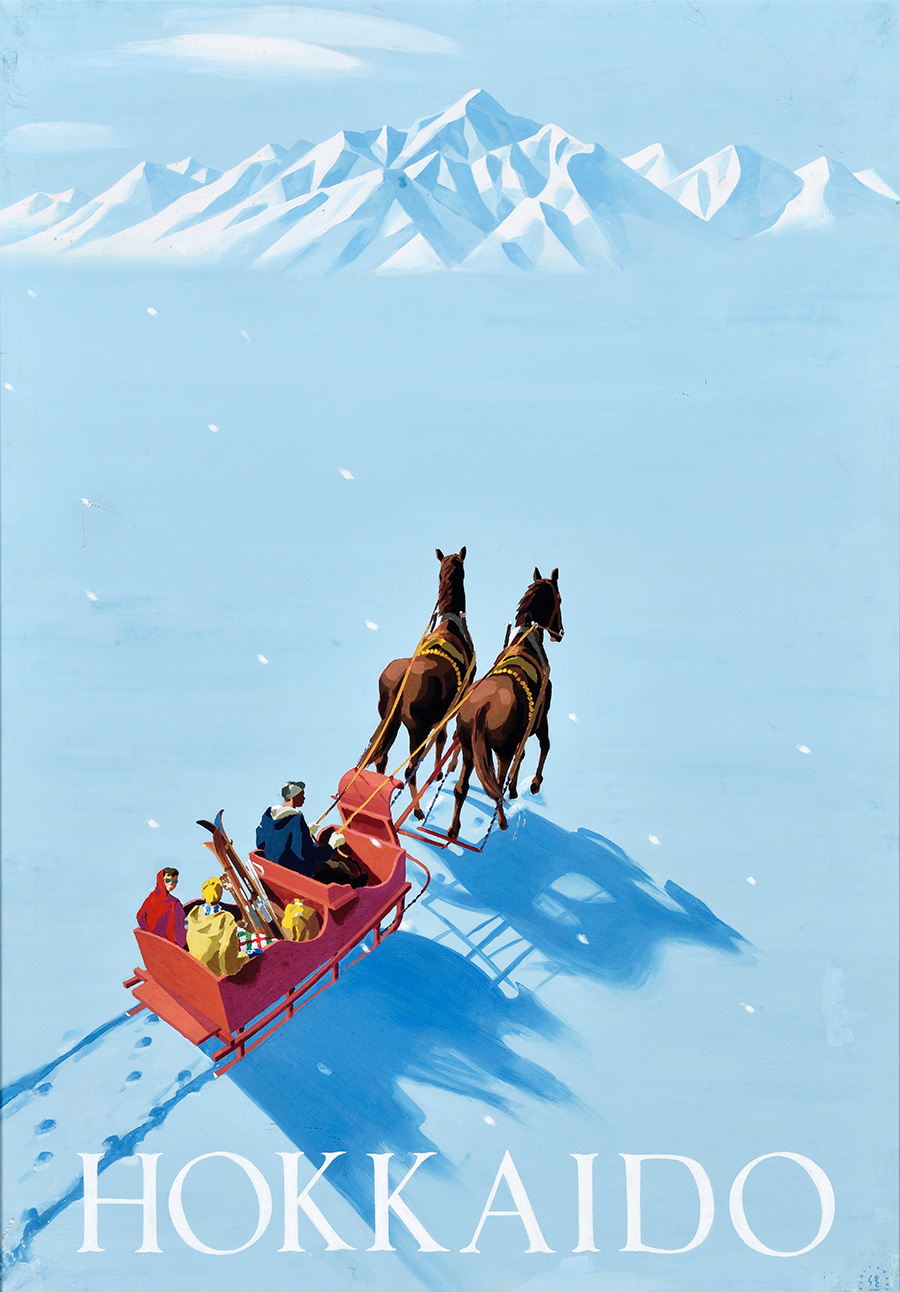Art in Hokkaido
The name Hokkaido was first given to this island in 1869. Since then its history has been defined largely by its geographic location at the northern extremity of the Japanese archipelago, in close proximity to northern Asia, and by the social transformations accompanying the arrival of migrants and settlers from the rest of Japan. As a representative museum of this region, the Hokkaido Museum of Modern Art actively collects works by artists who were born in Hokkaido from the Meiji era on, as well as those who lived here or made it their base of practice. Our collection encompasses such fine-art genres as painting, sculpture, and printmaking as well as crafts, design, and photography.
Through our acquisitions to date, we have assembled a collection that provides a substantially systematic, comprehensive introduction to creative endeavors in Hokkaido from the Meiji up through the Showa era, particularly in the areas of fine arts and ceramics (the Egami Hisayuki Collection). Moreover, our collection includes many masterworks that could be called the quintessence of Hokkaido art. In the future we hope to expand our acquisitions to include works of the Heisei era on, as well as in creative media of growing social significance that we have not addressed to date.
Since its opening, this museum has considered its purview to be "regional and international." The conjunction "and" signifies that these two principles are not mutually exclusive. The regional art of Hokkaido has been greatly influenced by international trends. Furthermore, the museum has long made it a point to introduce art from other northern regions of the world, such as Canada and Scandinavia, precisely because we view Hokkaido as part of the same global zone. Thus it has always been our aim to explore Hokkaido's regionality from an international perspective. The intermingling of regional and international elements is a premise that guides our evaluation of the works in our collection.
Collecting art entails evaluation and therefore criticism. To paraphrase the American critic Clement Greenberg, the role of criticism is to scrutinize the main currents of art. The main current of internationality in modern art was once Western modernism, but that has not been true for some time. The need to judge quality inherent to the act of collecting is further subject to such pitfalls as the exaggeration of imagined regional characteristics or the obsessive compilation of details (per Walter Benjamin's "chronicler of the times"). In order to develop a regional art collection that is future-oriented, and even future-anticipating, the museum must repeatedly update the specific meaning of this premise of intermingling regionality and internationality, continually polishing the lens through which we scrutinize the world today and visualize the world tomorrow.
Number of works in the "Art in Hokkaido" collection: 3,096 (as of March 31, 2024)
HAYASHI Takejiro
The Morning Prayer
Born in Miyagi prefecture, Hayashi studied Western painting at the Tokyo Fine Arts School (now Tokyo University of the Arts). From 1898 he taught art in several Sapporo schools, subsequently becoming a pivotal figure in art education in Hokkaido. This painting depicts a family gathered around a low table in morning prayer. The image of the little child's head resting on the mother's knee is particularly touching. The model is Hayashi's own family, devout Christians who prayed together every morning and evening. The boy with his hands on the Bible is a high-school student who lodged with the family. The only entry from Hokkaido selected for inclusion in the first Bunten exhibition in 1907, this is a significant work that heralded the arrival of Western-style painting in Hokkaido.
HAYASHI Takejiro (1871-1941)
The Morning Prayer
1906, oil on canvas, 50.0 × 90.0 cm
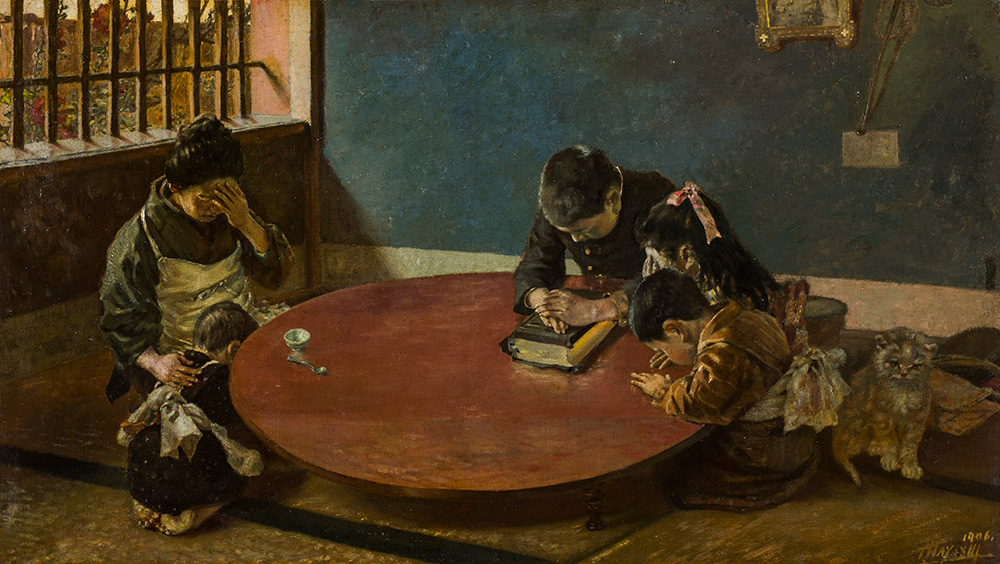
KIDA Kinjiro
Moiwa in Autumn
Born in Iwanai, Hokkaido, Kida was exposed to new currents in art when he entered high school in Tokyo in 1908. He returned to Hokkaido in 1910 and visited Arishima Takeo after being impressed by the novelist's painting, which he viewed at the Kuroyurikai exhibition at the Tohoku Imperial University College of Agriculture (now Hokkaido University) in Sapporo. Arishima became a major champion of Kida's artistic efforts. Settling in his hometown, Kida painted scenes of the Iwanai area, the sea, and the Daisetsuzan mountains. Moiwa in Autumn depicts a large rock at Moiwa on the coast of the Shakotan Peninsula. Kida made a series of paintings of Moiwa in spring, autumn and winter, sketching it from different angles. His rough, rapid brushwork powerfully expresses the harmony of sea, rock, and sky. The work testifies to the sharp eye with which Kida captured the essence of nature.
KIDA Kinjiro (1893–1962)
Moiwa in Autumn
1961, oil on canvas, 72.7 × 100.0 cm
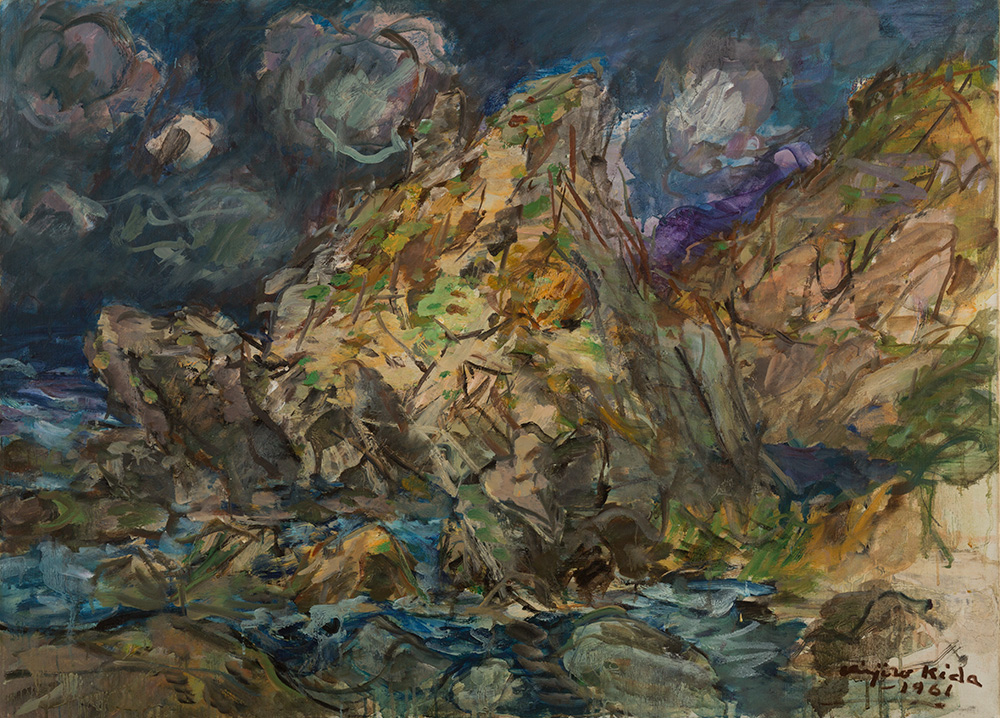
NAMBATA Tatsuoki
Autumn Poem
Born in Asahikawa, Hokkaido, Nambata moved to Tokyo before he was a year old. A meeting with the poet and sculptor Takamura Kotaro inspired him to become a painter. After World War II he devoted himself to abstract painting, and was designated a Person of Cultural Merit in 1996. Influenced by the Informel and Abstract Expressionist movements, he began using the dripping technique in the 1960s. In this work, automatically rendered lines of black enamel curve gracefully across a white background, overlapping and intersecting with one another. Nambata saw this mode of expression as sharing something in common with sumi-ink paintings. The vitality and lyricism of this spatial world can be attributed to the artist's East Asian aesthetic and his refined sensibilities.
NAMBATA Tatsuoki (1905–1997)
Autumn Poem
1961, oil and enamel on canvas, 112.1 × 193.9 cm
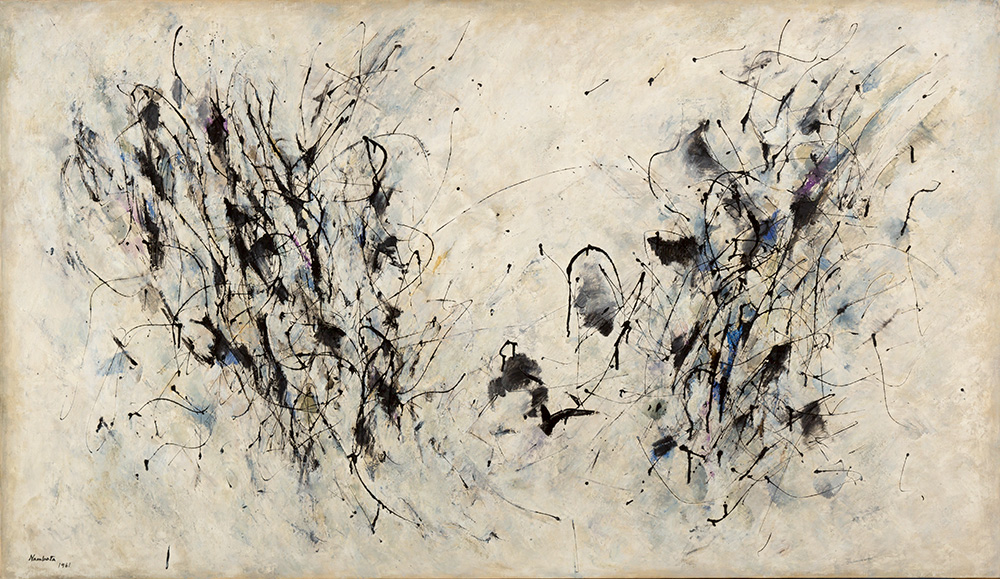
KANDA Nissho
Interior
Born in Tokyo, Kanda resettled with his family in Shikaoi, Hokkaido on the day before World War II ended. While working on the family farm he began oil painting, portraying familiar sights like workhorses, cows, and laborers with powerful brushwork. The Kanda Nissho Memorial Museum of Art opened in Shikaoi in 1993. This representative work was painted in the last year of Kanda's short life. Farming households in Hokkaido used to cover their walls with newspapers to keep out the cold wind, so this is a realistic scene from the artist's daily life. However, objects like the doll, clock, and paper bag strewn across the floor seem, like the newspapers, incongruous as elements of a realistic painting. The man hugging his knees in the center appears to be a projection not only of the artist himself, but also of the isolation of human beings amid the fictions of the modern age.
KANDA Nissho (1937–1970)
Interior
1970, oil on board, 227.3 × 181.8 cm

SUGIYAMA Rumiko
HERE-NOW: The Buddha's Eternal Light
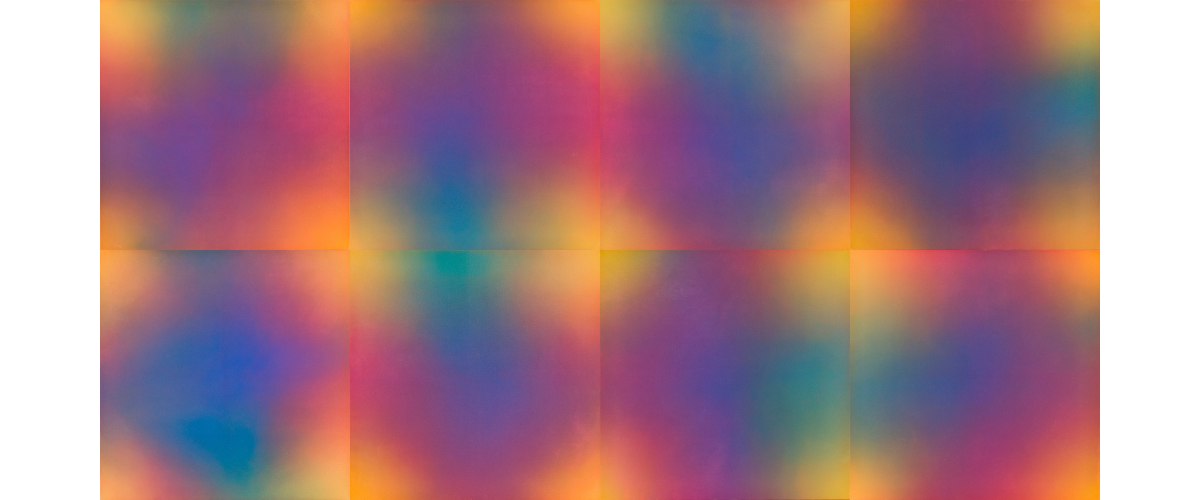
Born in Sapporo, Sugiyama was a leading figure among contemporary artists in Hokkaido, participating early on in such avant-garde movements as the group TODAY. In 1974 she began a series of "personal mandalas," geometric motifs that floated above the picture plane and earned notice as a Far Eastern form of abstract painting. From the 1990s on she would cover the entire picture plane with fields of pure color, and late in life she created a unique pictorial world of color that seemed to glow with light. The "eternal light" (muge-ko) of this work's title is a Buddhist term literally meaning "light free from obstacles," referring to the light of mercy emanating from the Buddha. By covering cotton canvas with layers of acrylic paint soaked with water, Sugiyama produced colored spaces that really do seem to radiate light.
SUGIYAMA Rumiko (1942–2013)
HERE-NOW: The Buddha's Eternal Light
2007, acrylic on cotton canvas, 90.9 × 90.9 cm each (set of 8)
HANADA Kazuharu
Earth
Born in Sapporo, Hokkaido, Hanada studied oil painting at Tokyo University of the Arts and completed graduate school there. Returning to Sapporo in 1974, he began participating in contemporary art exhibitions in Hokkaido in 1977. Devoting himself to compositions consisting of clearly delineated fields of contrasting color, he initially drew inspiration from familiar objects, while also influenced by American hard-edge painting. In the 1980s he shifted toward a form of abstraction that actively incorporated figurative elements derived from such motifs as the hills near his home, Hokkaido landscapes, and human faces. This work was inspired by Endless Column, a sculpture by Constantin Brâncuşi. The two diamond shapes evoke the silhouette of the sculpture, but also suggest a crevasse in an ice field with the full moon shining above. This oscillation between the figurative and the abstract, through which the artist liberates his expression from both, epitomizes Hanada's artistry.
HANADA Kazuharu (1946–2017)
Earth
1994, oil on canvas, 194.0 × 85.0 cm
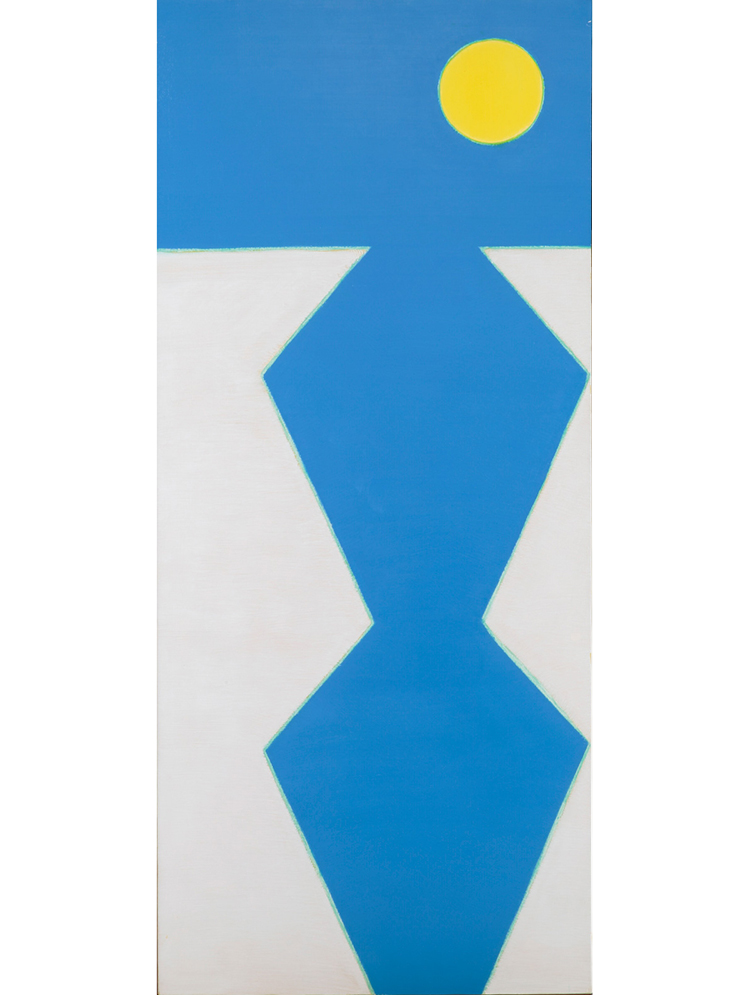
KAKIZAKI Hakyo
Japanese Spaniel with Clematises
Born in Fukuyama Castle in Matsumae, Hokkaido, Kakizaki was the fifth son of the lord of the Matsumae domain. He studied Chinese realist painting with Nanbin School artist So Shiseki in Edo, then studied with the Maruyama School in Kyoto. He produced elegant bird-and-flower paintings as well as bijinga (pictures of beautiful women) while serving as chief retainer of the Matsumae domain. His Ishu Ritsuzo, a series of twelve portraits of indigenous Ainu leaders (housed in the Musée des Beaux-Arts et d'Archéologie de Besançon and elsewhere) is noted for a distinctive style among early-modern Japanese works, positioning Kakizaki as arguably the first true painter to be born in Edo-period Hokkaido. In this work, a Japanese spaniel staring wide-eyed at a fluttering butterfly is surrounded by clematis flowers. The tension of the composition and the graceful brushstrokes of the dog's fur testify to the mature style of the artist. The signature and seal indicate that it was painted around 1813.
KAKIZAKI Hakyo (1764–1826)
Japanese Spaniel with Clematises
c.1813, color on silk, mounted on scroll, 44.3 × 65.6 cm

IWAHASHI Eien
Hokkaido Reminiscence

Born in Takikawa, Hokkaido, Iwahashi moved to Tokyo at age 21 and studied with Nihonga artist Yamauchi Tamon. He earned acclaim for his large-scale depictions of natural phenomena and landscapes, receiving the Order of Culture in 1994. This 29-meter-long work, in the form of a horizontal scroll, was completed by Iwahashi at age 79 after many years of preparation. The four seasons of Hokkaido—from the deep snows of winter to the late spring, the brief summer and autumn, then back to the long winter—quietly yet vividly unfold against the backdrop of a single day from sunrise to sunset. The autumn scene of countless red dragonflies hovering over rice fields dyed red in the sunset is particularly stunning. Drawing upon his childhood memories, this lyrical depiction of the Hokkaido landscape is a masterful summing-up of Iwahashi's career as an artist.
IWAHASHI Eien (1903–1999)
Hokkaido Reminiscence
1978-82, color on paper, framed, 60.7 × 2908.8 cm
KATAOKA Tamako
Countenance Series: Utagawa Kuniyoshi (Ukiyoe Artist) and Suzuki Juzo (Ukiyoe Scholar)
Born in Sapporo, Hokkaido, Kataoka attended the Women’s School of Fine Arts (now Joshibi University of Art and Design) in Tokyo. Until her death at age 103 she continously exhibited Nihonga works known for their bold compositions and vivid colors, primarily at the Inten exhibition. In 1989 she was awarded the Order of Culture. At age 61 she began her "Countenance Series" of portaits of historical figures, declaring that "I was always most interested in the human face." She was particularly fascinated by ukiyo-e artists whose works reflected a commitment to their own personal approach, and painted homages to such figures. In this painting she brings together Suzuki Juzo, a contemporary scholar of ukiyo-e, and the artist Kuniyoshi, who is contemplating the composition of his large nishiki-e triptych Big Catch Making Prosperity for Seven Bays, an image of which appears in the background.
KATAOKA Tamako (1905–2008)
Countenance Series: Utagawa Kuniyoshi (Ukiyoe Artist) and Suzuki Juzo (Ukiyoe Scholar)
1988, color on paper, framed, 204.0 × 372.0 cm
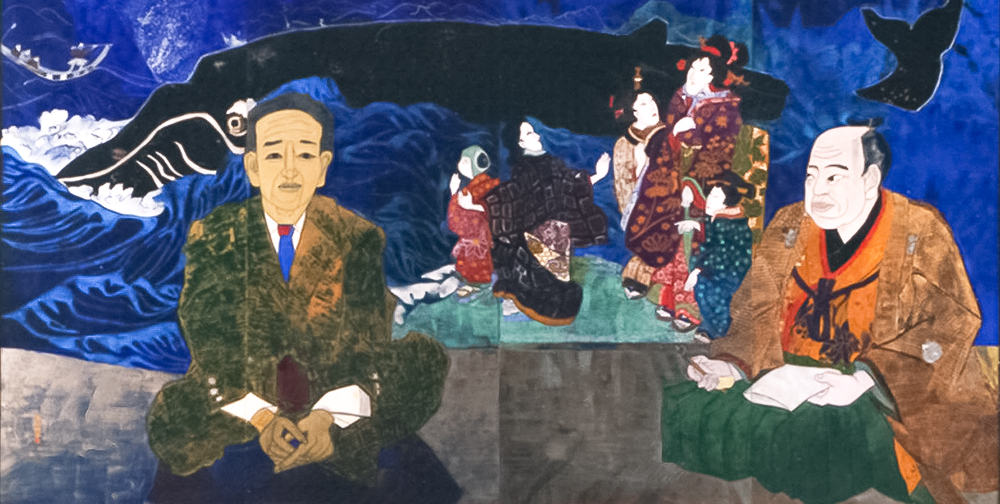
NAKAHARA Teijiro
Young Caucasian
Born in Kushiro, Hokkaido, Nakahara studied art with Hayashi Takejiro at what is now Sapporo Minami High School. Initially he wanted to be a painter, but switched to sculpture after moving to Tokyo in 1905 and meeting the sculptor Ogiwara Morie. The few works he completed before dying at the young age of 32 cemented his status as a key figure in modern Japanese sculpture. In this work, the face is composed of a series of large planes, forming a portrait with a robust presence. It may be said to represent Nakahara's interpretation of the Rodinesque view of sculpture as an expression of mass itself, not mere mimicry. The writer Akutagawa Ryunosuke wrote of this work, "Is there anyone in love with this bronze 'young man' by Nakahara Teijiro? The 'young man' is still alive."
NAKAHARA Teijiro (1888–1921)
Young Caucasian
1919, bronze, 18.0 × 19.5 × 41.5 cm
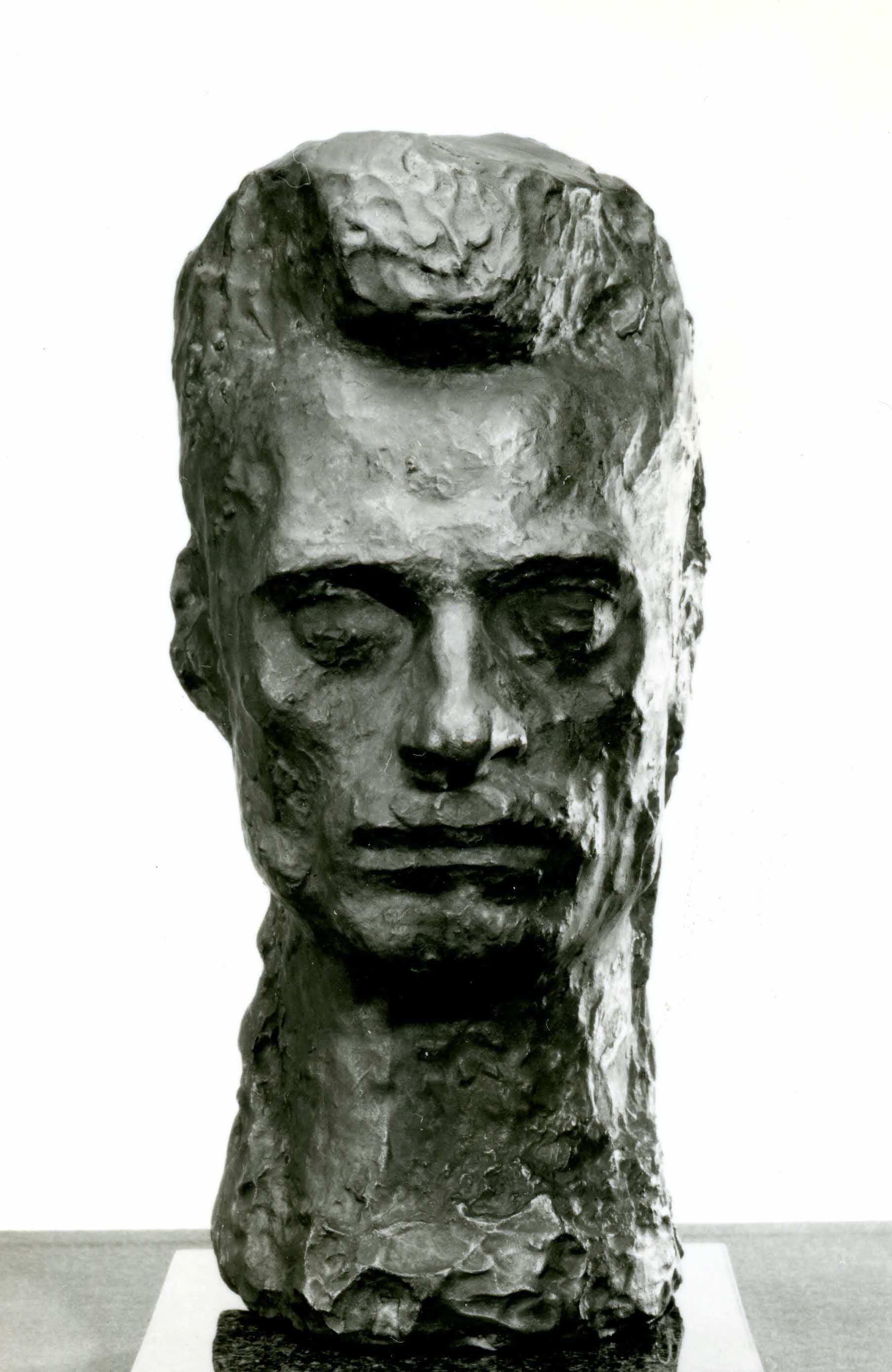
ABE Ten'ei
Sir, or Rebirth
Born in Sapporo, Hokkaido, Abe spent his childhood in the village of Shimamaki facing the Sea of Japan. In high school he learned to draw avant-garde pictorial calligraphy and became interested in fine art, which he began to study on his own with ambitions of becoming a painter. In the 1960s he participated in Hokkaido's avant-garde art movement through such groups as Soshiki in Sapporo, later taking a leading role in the movement. From painting he moved on to making objects and reliefs from materials like urethane and metal, then to sculptures and installations using wood. Undergirding this trajectory were his personal exploration of materials and their uses, his bold rejection of conventional art, and his lighthearted propensity for play. In this work he has covered wooden pillars with countless carving marks, coated the surfaces with graphite, and polished them with a scrub brush. Abe says that the challenge of working with hard, heavy wood reminds him of his woodchopping chores as a young boy, and that to make something by tackling nature with all one's might is to live. This austere work may be said to express that primordial relationship between nature and man.
ABE Ten'ei (1939–)
Sir, or Rebirth
1994, wood (castor aralia, hop-hornbeam, elm) and graphite, 200.0 × 250.0 × 200.0 cm

KAKIZAKI Hiroshi
From the edge of a forest
Born in Rumoi, Hokkaido, Kakizaki studied art at the Hokkaido University of Education. In the early 1970s he began showing his work in avant-garde group exhibitions, and in the 1990s and 2000s he played a leading role in organizing Portraits of a Water Vein, a collaborative exhibition by contemporary Korean and Hokkaido artists, and the Hokkaido Three-Dimensional Art exhibition. He began to make three-dimensional works with plaster in the late 1970s, and in the late 1980s started creating relief-like constructions of wood and cloth. In the 1990s he launched his series From the edge of the forest. This work, which belongs to that series, signifies Kakizaki's transition from working with multiple colors to pure white. The combination of delicate carvings and serene whiteness, together with the rhythmical arrangement of the forms at spacious intervals across the wall, conveys the artist's playful engagement with the living world of plants.
KAKIZAKI Hiroshi (1946–)
From the edge of a forest
2003, wood (katsura, castor aralia) and acrylic, 120.0 × 850.0 × 240.0 cm

KUNIMATSU Asuka
Wind
Born in Otaru, Hokkaido, Kunimatsu studied sculpture at Tokyo University of the Arts before returning to Hokkaido. A major figure among artists born after World War II, he was an organizer of the Hokkaido Contemporary Artists Exhibition in 1977. After a period of experimental printmaking, he began producing three-dimensional works in 1978. Initially working with a variety of materials like plywood and polyester, he eventually settled on iron, corten and stainless steel, while his style also evolved from single sculptures to multi-component installations. In the 1980s he began erecting numerous large outdoor monuments around Hokkaido. This work won the top prize at the Hokkaido Art '87: Images of Sound exhibition (Hokkaido Museum of Modern Art, 1987). The movement vividly expressed by its lines and surfaces conveys a light image of the wind that belies the weight of the iron it is made of.
KUNIMATSU Asuka (1947–)
Wind
1986, iron, 180.0 × 106.0 × 219.0 cm
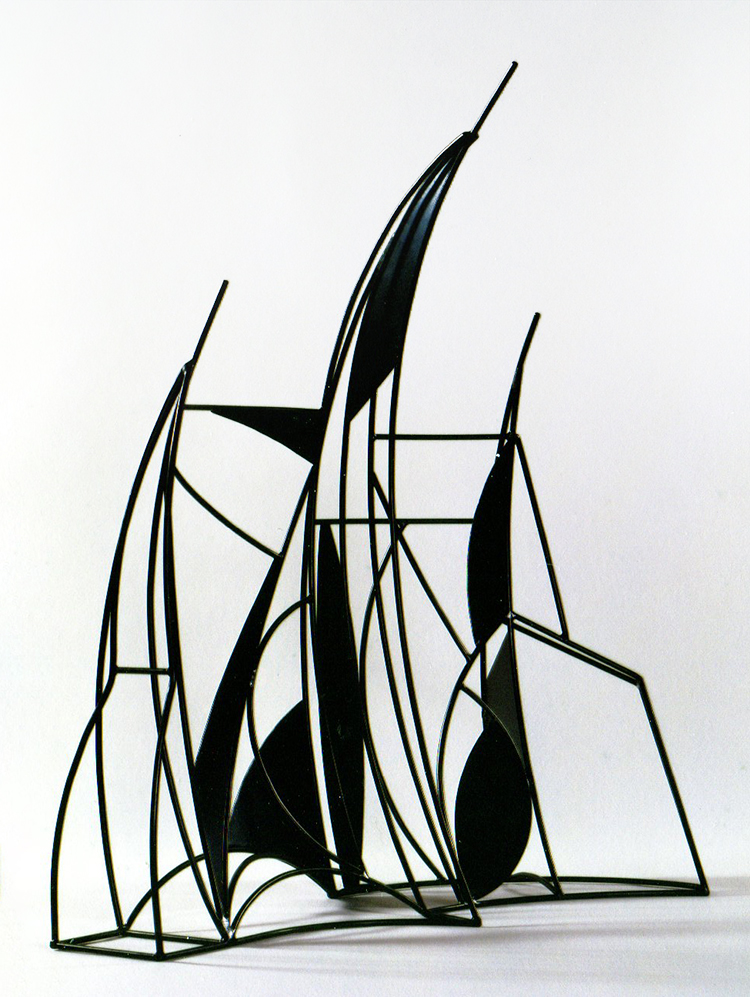
ICHIHARA Arinori
SON・ZON
Born in Tokushima prefecture, Ichihara moved with his family to Makkari, Hokkaido at age three, but spent most of his adult life in Otaru. Developing his own original monotype technique, he made his debut as a print artist when he was almost fifty and went on to create a body of innovative work that defied printmaking conventions and reflected his prodigious appetite for experimentation. In Ichihara's monotypes, ink is spread evenly on a metal plate, then cut away with a scraper to produce an image that is printed on a press. In his seventies and early eighties he created large prints from rows of monotypes; this work is the first such effort. A cylindrical monotype in three dimensions occupies the foreground. The integration of rigid materials conveys a sensation of movement, conjuring up a fantastic world that seems part of a boundless expanse of space.
ICHIHARA Arinori (1910–2010)
SON・ZON
1960-79, monotype on paper, 248.0 × 110.0 cm (cylinder: 30.2 × 211.5 cm)
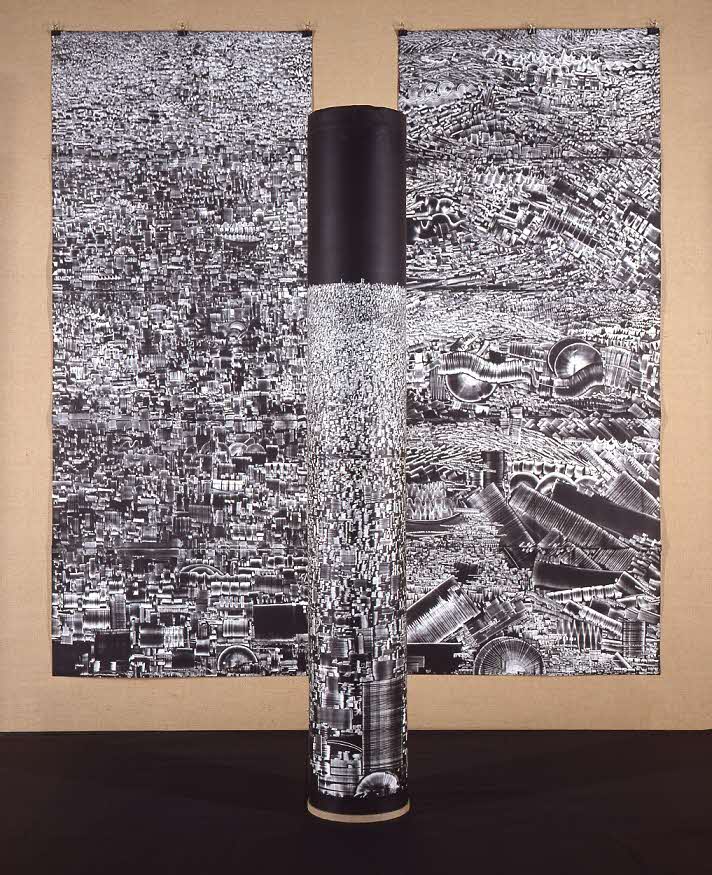
OKABE Masao
#165 le 26 septembre 1979 á rue Pasteur
Born in Nemuro, Hokkaido, Okabe began participating in avant-garde art groups like Soshiki in Sapporo in the late 1960s. Since the mid-1970s he has employed the frottage technique, pressing paper or cloth against walls or streets and making rubbings of these surfaces with pencil or oil chalk. Treating the city as a "giant plate" engraved with human memories and the events of modern history, he seeks to "strip off its skin" to reveal the buried history of groups and individuals, as well as its ambiguous meanings. He has produced these works, often in collaboration with local citizens, in such places as Paris, Hiroshima, Gwangju, and Fukushima, the latter in the wake of the Great East Japan Earthquake. In 2007 he represented Japan at the Venice Biennale. Titled #165 le 26 septembre 1979 á rue Pasteur, this work is a standout among the 169 frottages Okabe made during a sojourn in Paris from April to October 1979. The Paris series enjoyed critical acclaim when it was exhibited at solo shows in Sapporo and Tokyo the following year, in 1980.
OKABE Masao (1942–)
#165 le 26 septembre 1979 á rue Pasteur
1979, frottage, pencil on paper, 189.0 × 189.0 cm
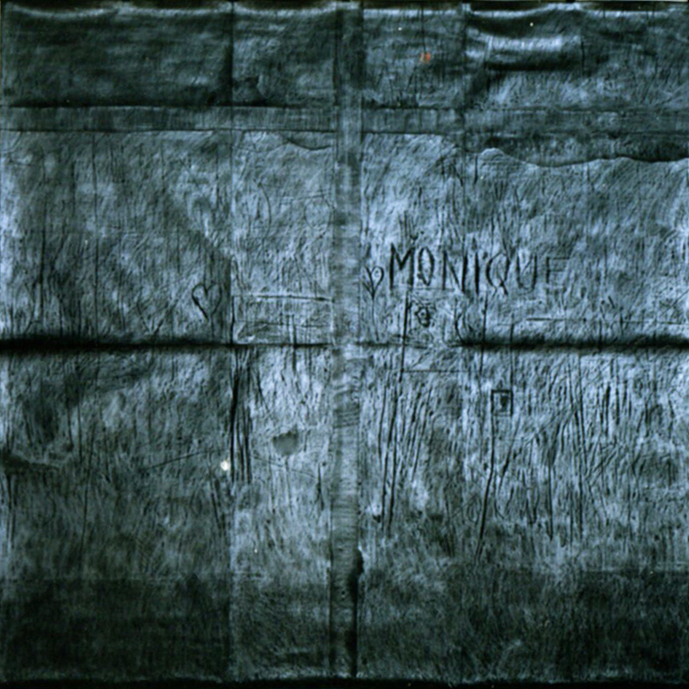
KOMORI Shinobu
Vase
Born in Osaka city, Komori researched glazes and Chinese ceramics at the Kyoto Ceramic Research Institute and in Dalian, Manchuria. In 1949 he moved to Hokkaido and settled in Ebetsu, where he served as an advisor on ceramics production technology and conducted research on materials found in Hokkaido. He also founded the Komori Ceramics Research Institute and Hokuto-gama Kiln. Despite Hokkaido's harsh climate and its brief history in ceramic art, Komori strove to create works that "bring out the beauty of Hokkaido's native materials and its northern environment," incorporating natural forms and indigenous Ainu patterns in his designs. The body of this vase features a large snowflake pattern, and the crystalline glaze around it resembles ice. The work represents the fruition of Komori's long years of research on glazes and his innovative efforts in this northern clime.
KOMORI Shinobu (1889–1962)
Vase
c.1957, ceramic, 17.0 × 31.5 cm
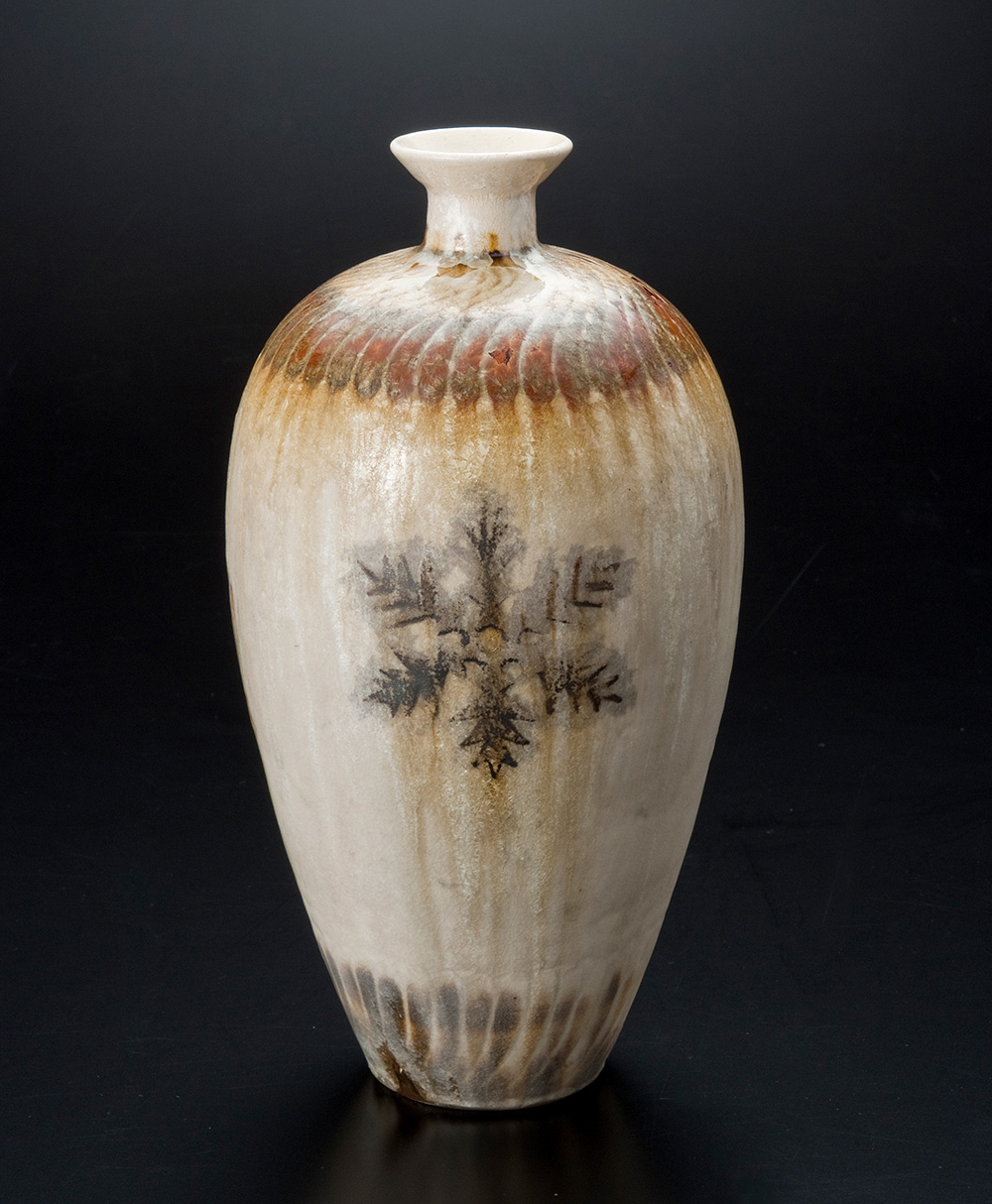
NAKAMURA Kimi
The Girl Eats Pigeon
Born in Sapporo, Hokkaido, Nakamura studied in Tokyo at the Women’s College of Fine Arts (now Joshibi University of Art and Design) and at Kuwasawa Design School. In addition to developing an original method of macrame, a kind of lacework in which threads are knotted around the fingertips, she is known for her use of cords dyed in bright colors to hand-weave large, spontaneously derived abstract forms. This work is a life-sized three-dimensional figure made for her 2012 solo show With Love to the Living Creatures I Love at Gallery mu・on in Nagaoka, Niigata prefecture. With its provocative title and animal-like head and colorful costume, the standing figure spurs viewers to imagine a character in a masked drama or an ancient myth.
NAKAMURA Kimi (1934–)
The Girl Eats Pigeon
2009, twisted cotton thread, metal frame, 43.0 × 33.5 × 168.0 cm

KURIYAGAWA Ken'ichi
Red Horse-drawn Sled (Original Painting)
Born in Iwamizawa, Hokkaido, Kuriyagawa was raised in a farming household. In the years before World War II he taught himself graphic design, and after the war he turned out a prodigious number of Hokkaido-themed travel posters that garnered acclaim both in Japan and abroad. He also designed product packages, decorated the permanent exhibition gallery of the Hokkaido Development Memorial Hall (opened in 1971), and painted murals for Sapporo Station as well as founding a design school, earning him a deserved reputation as the "father of Hokkaido design." This work is one of the many original paintings for posters by Kuriyagawa in the possession of the Hokkaido Museum of Modern Art. A painting of Hokkaido in winter that was commissioned for a travel poster by Japan National Railways, it is described in a newspaper article as "a depiction of skiers approaching the foot of the Tokachi Mountains by horse-drawn sleigh, with the pure-white mountains floating in the distance."
KURIYAGAWA Ken'ichi (1911–1999)
Red Horse-drawn Sled (Original Painting)
1956, poster color on paper, 101.2 × 71.1 cm
